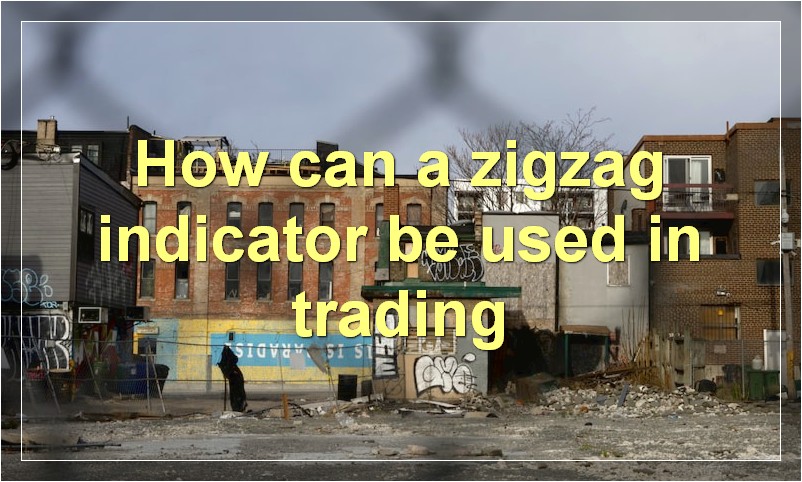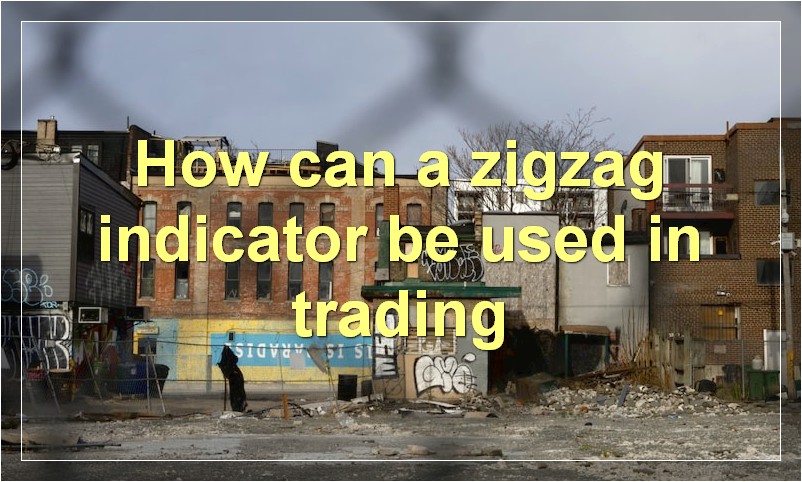If you’re looking to take your trading to the next level, then you need to know about zigzag indicators. In this article, we’ll break down everything you need to know about these essential tools.
What is a zigzag indicator
A zigzag indicator is a technical analysis tool that identifies price reversals by looking at peaks and troughs in the market. The zigzag indicator can be useful for identifying trend changes, as well as potential support and resistance levels. The indicator is created by drawing a series of connected lines between tops and bottoms in the market, with the lines alternating between up and down movements.
How can a zigzag indicator be used in trading

The zigzag indicator is a technical analysis tool that can be used to identify trends in the market. The indicator is made up of a series of straight lines that connect highs and lows in the market. The zigzag indicator can be used to trade both long and short-term trends.
The zigzag indicator is a valuable tool for traders because it can help to identify when a market is about to move in a certain direction. The indicator can also be used to confirm trends that are already underway. For example, if the zigzag indicator is showing a series of lower highs and lower lows, this is an indication that the market is in a downtrend. Conversely, if the zigzag indicator is showing a series of higher highs and higher lows, this is an indication that the market is in an uptrend.
The zigzag indicator can also be used to generate buy and sell signals. For example, if the indicator is showing a series of lower highs and lower lows, this may be an indication that the market is about to turn downwards. In this case, a trader may look to sell their position or go short on the market. Alternatively, if the zigzag indicator is showing a series of higher highs and higher lows, this may be an indication that the market is about to turn upwards. In this case, a trader may look to buy their position or go long on the market.
The zigzag indicator is a useful tool for traders who are looking to take advantage of both long and short-term trends in the market. The indicator can be used to generate buy and sell signals, as well as to confirm existing trends. When used correctly, the zigzag indicator can be a valuable addition to any trader’s toolkit.
What are the benefits of using a zigzag indicator
There are many benefits of using a zigzag indicator, but the three main benefits are that it can help identify trend reversals, it can be used as a trend following tool, and it can be used to generate trading signals.
The zigzag indicator can be very useful in identifying trend reversals. This is because the zigzag pattern is often seen at the end of a trend, which signals that the trend is about to reverse. The zigzag indicator can also be used as a trend following tool. This is because the zigzag pattern can be used to identify when a trend is beginning and when it is ending. The zigzag indicator can also be used to generate trading signals. This is because the zigzag pattern can be used to identify when a market is overbought or oversold.
How does a zigzag indicator work
A zigzag indicator is a technical analysis tool that is used to identify major trend reversals. The zigzag indicator is composed of a series of connected dots that form a zigzag pattern. When the zigzag indicator is applied to a chart, it is used to identify when the price of a security has made a sharp move in one direction and then quickly reversed course.
Are there any drawbacks to using a zigzag indicator
There are a few drawbacks to using a zigzag indicator. First, the zigzag can be late to signal a change in trend. Second, the zigzag can give false signals in choppy markets. Third, the zigzag can be lagging when prices make sharp moves.
How do I choose the best zigzag indicator for my needs

If you’re a trader who’s looking for a zigzag indicator, then you might be wondering how to choose the best one for your needs. There are a few things that you’ll want to consider before making your decision.
First, you’ll need to think about what time frame you’re trading on. The zigzag indicator is most effective on longer time frames, so if you’re trading on a shorter time frame, you might not get the results you’re looking for.
Second, you’ll need to consider what type of trader you are. Are you a trend trader or a counter-trend trader? The zigzag indicator can be used effectively by both types of traders, but it’s important to know which type of trader you are before choosing an indicator.
Third, you’ll need to consider your trading style. Do you like to trade with a lot of indicators or just a few? If you like to trade with a lot of indicators, then you might want to choose an indicator that gives you more signals. However, if you prefer to trade with just a few indicators, then you might want to choose an indicator that gives you fewer signals.
Fourth, you’ll need to consider your risk tolerance. The zigzag indicator can be used to take on more risk or less risk, depending on your preferences. If you’re willing to take on more risk, then you might want to choose an indicator that gives you more signals. However, if you’re not comfortable with taking on too much risk, then you might want to choose an indicator that gives you fewer signals.
These are just a few things that you’ll want to consider when choosing the best zigzag indicator for your needs. By taking the time to consider these factors, you’ll be able to find an indicator that will help you achieve your trading goals.
What are some common settings for a zigzag indicator
There are many different settings for a zigzag indicator, and it really depends on what you are looking for in an indicator. Some common settings include the following:
-The number of bars to look back: This setting will determine how far back the zigzag indicator will look when trying to identify a trend. A higher number will mean that the indicator is less likely to give false signals, but it will also take longer for the indicator to signal a change in direction.
-The depth of the zigzag: This setting determines how much of a price move must occur before it is considered part of a trend. A deeper zigzag will filter out more “noise” in the price data, but it will also take longer for the indicator to signal a change in direction.
-The minimum price move: This setting is similar to the depth setting, but it is applied to individual price bars instead of the overall price move. This setting filters out small price fluctuations that are not indicative of a true change in direction.
These are just a few of the most common settings for a zigzag indicator. Experiment with different settings to see what works best for your trading style and market conditions.
Can I use a zigzag indicator on all time frames
There are a few things to consider when using a zigzag indicator on different time frames. First, the indicator will be more accurate on longer time frames. This is because there is more data to work with and the indicator can better filter out noise. Second, the indicator will give false signals on shorter time frames. This is because there is less data to work with and the indicator is more likely to be influenced by noise. Finally, it is important to use other indicators in conjunction with the zigzag indicator to get a better picture of what is happening in the market.
How do I interpret a zigzag indicator
If you’re trying to figure out how to interpret a zigzag indicator, there are a few things you need to keep in mind. First of all, remember that the zigzag indicator is just a tool, and it’s not perfect. It can’t tell you exactly what’s going to happen in the market, but it can give you some clues.
One of the most important things to remember about the zigzag indicator is that it’s based on price action. This means that it looks at the candles on a chart and tries to identify patterns. The problem is that sometimes these patterns can be pretty hard to spot.
That’s why it’s important to use other indicators along with the zigzag indicator. For example, if you see a candlestick pattern that looks like a head and shoulders pattern, you might want to take that as a sign that the market is about to turn around.
Another thing to keep in mind is that the zigzag indicator is only good at identifying short-term trends. This means that if you’re looking at a longer-term chart, you might not see the same patterns that you would on a shorter-term chart.
Finally, don’t forget that the zigzag indicator is just one tool in your toolbox. There are other indicators out there that can help you make better decisions about when to buy and sell.
Is there any software that can help me trade with a zigzag indicator
The Zigzag indicator is a technical analysis tool that can be used to identify trends in the market. There is no one specific software that can help you trade with a zigzag indicator, but there are many different software programs that have this functionality. Some examples of software programs that have this functionality include MetaTrader 4, TradingView, and NinjaTrader.

